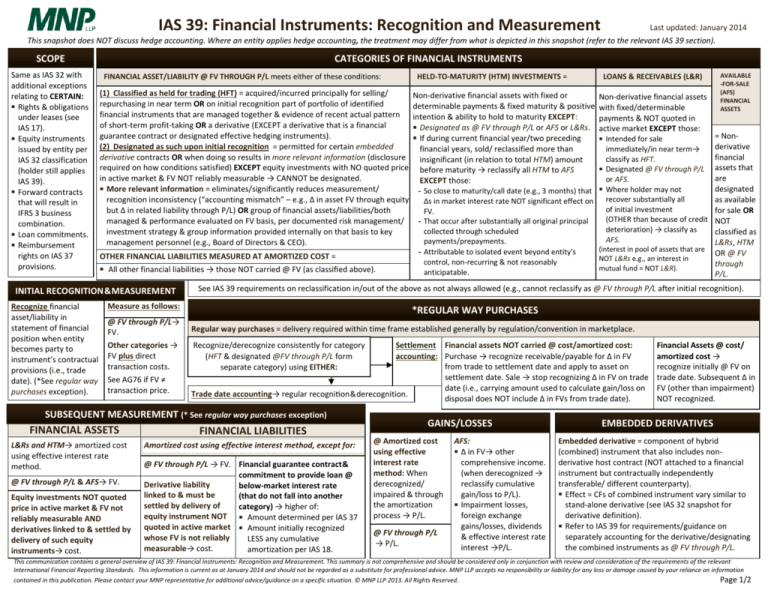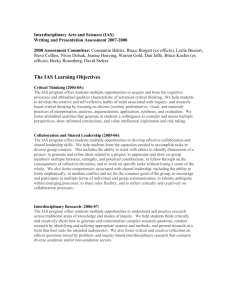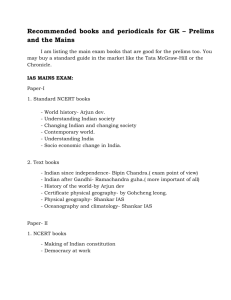
IAS 39: Financial Instruments: Recognition and Measurement
Last updated: January 2014
This snapshot does NOT discuss hedge accounting. Where an entity applies hedge accounting, the treatment may differ from what is depicted in this snapshot (refer to the relevant IAS 39 section).
SCOPE
Same as IAS 32 with
additional exceptions
relating to CERTAIN:
Rights & obligations
under leases (see
IAS 17).
Equity instruments
issued by entity per
IAS 32 classification
(holder still applies
IAS 39).
Forward contracts
that will result in
IFRS 3 business
combination.
Loan commitments.
Reimbursement
rights on IAS 37
provisions.
CATEGORIES OF FINANCIAL INSTRUMENTS
FINANCIAL ASSET/LIABILITY @ FV THROUGH P/L meets either of these conditions:
LOANS & RECEIVABLES (L&R)
=
(1) Classified as held for trading (HFT) = acquired/incurred principally for selling/
Non-derivative financial assets with fixed or
Non-derivative financial assets
repurchasing in near term OR on initial recognition part of portfolio of identified
determinable payments & fixed maturity & positive with fixed/determinable
financial instruments that are managed together & evidence of recent actual pattern intention & ability to hold to maturity EXCEPT:
payments & NOT quoted in
of short-term profit-taking OR a derivative (EXCEPT a derivative that is a financial
Designated as @ FV through P/L or AFS or L&Rs. active market EXCEPT those:
guarantee contract or designated effective hedging instruments).
If during current financial year/two preceding
Intended for sale
(2) Designated as such upon initial recognition = permitted for certain embedded
financial years, sold/ reclassified more than
immediately/in near term→
derivative contracts OR when doing so results in more relevant information (disclosure
classify as HFT.
insignificant (in relation to total HTM) amount
required on how conditions satisfied) EXCEPT equity investments with NO quoted price before maturity → reclassify all HTM to AFS
Designated @ FV through P/L
in active market & FV NOT reliably measurable → CANNOT be designated.
or AFS.
EXCEPT those:
More relevant information = eliminates/significantly reduces measurement/
Where holder may not
- So close to maturity/call date (e.g., 3 months) that
recognition inconsistency (“accounting mismatch” – e.g., Δ in asset FV through equity
Δs in market interest rate NOT significant effect on recover substantially all
of initial investment
but Δ in related liability through P/L) OR group of financial assets/liabilities/both
FV.
(OTHER than because of credit
managed & performance evaluated on FV basis, per documented risk management/
- That occur after substantially all original principal
deterioration) → classify as
collected through scheduled
investment strategy & group information provided internally on that basis to key
AFS.
payments/prepayments.
management personnel (e.g., Board of Directors & CEO).
(interest in pool of assets that are
- Attributable to isolated event beyond entity's
OTHER FINANCIAL LIABILITIES MEASURED AT AMORTIZED COST =
NOT L&Rs e.g., an interest in
control, non-recurring & not reasonably
mutual fund = NOT L&R).
All other financial liabilities → those NOT carried @ FV (as classified above).
anticipatable.
INITIAL RECOGNITION&MEASUREMENT
Recognize financial
asset/liability in
statement of financial
position when entity
becomes party to
instrument’s contractual
provisions (i.e., trade
date). (*See regular way
purchases exception).
HELD-TO-MATURITY (HTM) INVESTMENTS =
*REGULAR WAY PURCHASES
Regular way purchases = delivery required within time frame established generally by regulation/convention in marketplace.
Recognize/derecognize consistently for category
(HFT & designated @FV through P/L form
separate category) using EITHER:
Settlement Financial assets NOT carried @ cost/amortized cost:
accounting: Purchase → recognize receivable/payable for Δ in FV
from trade to settlement date and apply to asset on
settlement date. Sale → stop recognizing Δ in FV on trade
date (i.e., carrying amount used to calculate gain/loss on
Trade date accountingї ƌĞŐƵůĂƌƌĞĐŽŐŶŝƟŽŶ&derecognition.
disposal does NOT include Δ in FVs from trade date).
SUBSEQUENT MEASUREMENT (* See regular way purchases exception)
FINANCIAL ASSETS
L&Rs and HTM→ amortized cost
using effective interest rate
method.
@ FV through P/L & AFS→ FV.
Equity investments NOT quoted
price in active market & FV not
reliably measurable AND
derivatives linked to & settled by
delivery of such equity
instruments→ cost.
= Nonderivative
financial
assets that
are
designated
as available
for sale OR
NOT
classified as
L&Rs, HTM
OR @ FV
through
P/L.
See IAS 39 requirements on reclassification in/out of the above as not always allowed (e.g., cannot reclassify as @ FV through P/L after initial recognition).
Measure as follows:
@ FV through P/L→
FV.
Other categories →
FV plus direct
transaction costs.
See AG76 if FV ≠
transaction price.
AVAILABLE
-FOR-SALE
(AFS)
FINANCIAL
ASSETS
FINANCIAL LIABILITIES
Amortized cost using effective interest method, except for:
@ FV through P/L → FV. Financial guarantee contract&
commitment to provide loan @
Derivative liability
below-market interest rate
linked to & must be
(that do not fall into another
settled by delivery of
category) → higher of:
equity instrument NOT Amount determined per IAS 37
quoted in active market Amount initially recognized
whose FV is not reliably
LESS any cumulative
measurable→ cost.
amortization per IAS 18.
GAINS/LOSSES
@ Amortized cost
using effective
interest rate
method: When
derecognized/
impaired & through
the amortization
process → P/L.
@ FV through P/L
→ P/L.
AFS:
Δ in FV→ other
comprehensive income.
(when derecognized →
reclassify cumulative
gain/loss to P/L).
Impairment losses,
foreign exchange
gains/losses, dividends
& effective interest rate
interest →P/L.
Financial Assets @ cost/
amortized cost →
recognize initially @ FV on
trade date. Subsequent Δ in
FV (other than impairment)
NOT recognized.
EMBEDDED DERIVATIVES
Embedded derivative = component of hybrid
(combined) instrument that also includes nonderivative host contract (NOT attached to a financial
instrument but contractually independently
transferable/ different counterparty).
Effect = CFs of combined instrument vary similar to
stand-alone derivative (see IAS 32 snapshot for
derivative definition).
Refer to IAS 39 for requirements/guidance on
separately accounting for the derivative/designating
the combined instruments as @ FV through P/L.
This communication contains a general overview of IAS 39: Financial Instruments: Recognition and Measurement. This summary is not comprehensive and should be considered only in conjunction with review and consideration of the requirements of the relevant
International Financial Reporting Standards. This information is current as at January 2014 and should not be regarded as a substitute for professional advice. MNP LLP accepts no responsibility or liability for any loss or damage caused by your reliance on information
contained in this publication. Please contact your MNP representative for additional advice/guidance on a specific situation. © MNP LLP 2013. All Rights Reserved.
Page 1/2
IAS 39: Financial Instruments: Recognition and Measurement
Last updated: January 2014
This snapshot does NOT discuss Hedge Accounting. Where an entity applies Hedge Accounting, the treatment may differ from what is depicted in this snapshot. (Refer to the relevant IAS 39 section.)
DERECOGNITION OF FINANCIAL LIABILITIES
Remove (part of) financial liability from statement of
financial position when extinguished i.e., when
specified obligation discharged/cancelled/expires.
Exchange between existing borrower and lender with
substantially different terms OR substantial
modification to (part of) existing financial liability
(whether/not attributable to debtor’s financial
difficulty) →account as extinguishment of original &
recognition of new financial liability.
Carrying amount extinguished/ transferred to another
party LESS consideration paid (including non-cash
assets transferred/liabilities assumed) →recognize in
P/L.
DERECOGNITION OF FINANCIAL ASSETS
Consolidate all subsidiaries (including any SPE) see IAS 39.16.
Determine if the derecognition principles below
are applied to a part or all of an asset (or group
of similar assets) – see IAS 39.16.
Derecognise the asset.
IMPAIRMENT & REVERSAL OF IMPAIRMENT
(N/A to @ FV through P/L)
@ Amortised cost:
Impairment = carrying amount MINUS PV of estimated
future CFs discounted using original effective interest
rate → recognize in P/L.
Reverse (also in P/L) in subsequent period, if
impairment loss ↓ & ↓relate objectively to event
after impairment recognized. Cannot result in carrying
amount > amortized cost if no impairment recognized.
@ Cost:
Impairment loss = carrying amount MINUS PV of
estimated future CFs discounted @ current market
rate of return for similar financial assets → recognize in
P/L.
NOT reversed!
AFS:
Reclassify cumulative loss from comprehensive income
to P/L.
Cumulative loss reclassified = acquisition cost (net of
principal payment & amortization) MINUS FV (less
previous impairment recognized in P/L).
Equity instrument → impairment not reversed through
P/L.
Debt instrument → reverse (also in P/L) in subsequent
period, if FV ј Θј ƌĞůĂƚĞŽďũĞĐƟǀ ĞůLJƚŽĞǀ ĞŶƚĂŌĞƌ
impairment was recognized.
Yes
Have the rights to the cash flows from the asset
expired? – see IAS 39.17(a).
No
Has the entity transferred its rights to receive the
cash flows from the asset? – see IAS 39.18(a).
No
Yes
Has the entity assumed an obligation to pay the
cash flows from the asset that meets the
conditions in paragraph 19? – see IAS 39.18(b).
No
Continue to recognize the asset.
Yes
Yes
Has the entity transferred substantially all risks
and rewards? – see IAS 20(a).
No
Has the entity retained substantially all risks and
rewards? – see IAS 20(b).
Yes
No
No
Has the entity retained control of the asset? – see
IAS 20(b).
Yes
Continue to recognize the asset to the extent of
the entity’s continuing involvement.
This communication contains a general overview of IAS 39: Financial Instruments: Recognition and Measurement. This summary is not comprehensive and should be considered only in conjunction with review and consideration of the requirements of the relevant
International Financial Reporting Standards. This information is current as at January 2014 and should not be regarded as a substitute for professional advice. MNP LLP accepts no responsibility or liability for any loss or damage caused by your reliance on information
contained in this publication. Please contact your MNP representative for additional advice/guidance on a specific situation. © MNP LLP 2014. All Rights Reserved.
Page 2/2








